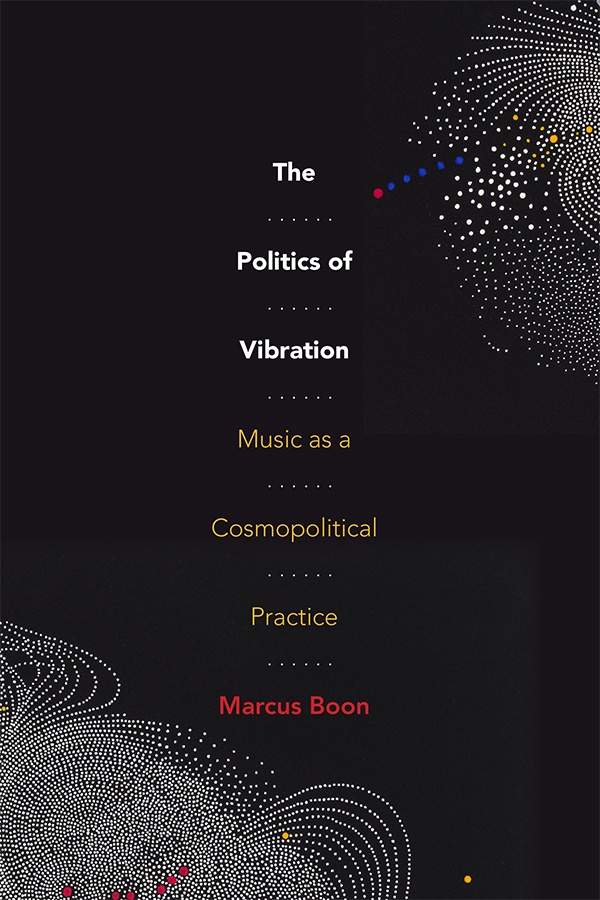The Politics of Vibration: Music as a Cosmopolitical Practice - Marcus Boon. Durham: Duke University Press, 2022
By Cat Hope
This book is a wonderful contribution to the burgeoning field of vibrational studies and so-called “esoteric” music. Vibration studies generally examines the nature of vibration as both an effect and affect within the field of sound studies. It finds similar ground in esoteric music, which is generally thought of as music appealing to those familiar with the specialized themes included within it. Boon frames vibration as an element of esoteric music whilst simultaneously acknowledging its materiality and establishes a model for thinking of music as born from the politics of vibration, engaging cosmopolitics as a foundational principal of that model. French philosopher Isabelle Stengers claimed the term cosmopolitical in her book Cosmopolitics 1 (2010) to describe a state where scientific explanations can coexist with other perspectives. Stengers’ work shows that science is a contingent enterprise that shapes as well as discovers truth, and in doing so, helps redefine what it means to belong to the world. Boon’s application of this to music unfolds through detailed theoretical positioning, but also, and importantly, through three music creators, surreptitiously linked together through various social and stylistic connections. These links cross over with the author’s personal experiences of the music, participation in the scenes described, and build on the relationships established between the author and the artists, mostly as a journalist, but also as a musician and fan. Given that the author’s most recent works have covered Buddhism – Nothing: Three Inquiries in Buddhism from 2015, co-authored with Eric Cazdyn and Timothy Morton – and artistic practice – the edited volume Practice (with Gabriel Levine) from 2018 – this volume is a natural progression from the themes of spirituality and doing and is all the better for Boon’s entanglement in these themes.
An important inclusion amongst the three selected artists is Swedish drone composer Catherine Christie Hennix, who passed away this year. An in-depth discussion of Hennix’s work has been largely neglected in music publications, making the detailed analysis here a welcome addition. The other artists featured in the book are Hindustani classical vocalist Prandit Pran Nath and Texas-based hip-hop creator DJ Screw. All three are drawn together through their creation of very slow music. This examination of slowness provides a perfect test zone for Boon’s ideas, probing both the physical and psychological aspects of the musical experience when it is drawn out and repeated. The cosmopolitical lens applied to these composers and their work weaves the elements of spirituality, physics, psychoanalysis, mathematics, and technology together through cultural perspectives and communities of practice. In so doing, the book provides new analytical methodologies for music as well as insights into the work of associated composers such as La Monte Young, John Cage, Keiji Haino, Henry Flynt, among others.
The book weaves theoretical and practical analyses together, creating a rewarding and readable work, where lived experiences of different cosmopolitical approaches sit alongside, and within, theoretical framings. This enables Boon to combine explorations of deeply considered theory with detailed artistic investigation, providing exciting and rewarding insights into different music-making approaches. The book moves seamlessly across short, personal reflections of the author’s experience to philosophical considerations that draw upon a range of perspectives. An important aspect of the book is its alignment of Stoever’s concept of the “sonic color line” with vibration, leading Boon to acknowledge the challenge of comprehending and transmitting differing arrangements of the outer (bodies making and sensing music) and inner (listening, understanding) experiences of music.. Additionally, as mentioned above, a detailed examination of Hennix’s work is overdue, and it was wonderful to see it fleshed out in the context of this book.
Boon challenges extant ontologies of music as objective and universal. Rejecting the idea of music as somehow provisionally captured by our concept of time, music is instead proposed as a manifestation of the infinitely possible. This is done clearly and gradually throughout the book, which positions music as a topological transformation of space rather than time, building on the organization of sonic vibration into sound that leads us to music. This approach brings an important acknowledgment that access to music within a society depends on access to vibration and that this access is not automatically nor fairly distributed. The result is a book that encourages us to ponder what music liberated from these limits could really be – stimulating further questions and imaginings. It prompts new insights into the relationship of music to time, community, politics, and philosophy, offering new perspectives for those interested in how music can be looped into new knowledges being generated within the field of sound studies. Highly recommended.

